Sean McBride's Blog, page 11
November 11, 2021
Blind Read Through: J.R.R. Tolkien; The Silmarillion, Of Thingol and Melian
 Thingol and Melian
Thingol and Melian“In after days, he became a king renowned, and his people were all the Eldar of Beleriand; the Sindar they were named, the Grey-elves, the Elves of Twilight, and King Greymantle was he, Elu Thingol in the tongue of that land.”
Welcome back to another Blind Read! This week we have a concise chapter, so I thought it would be the perfect time to review and dig into theories about what we’ve read so far in The Silmarillion.
This chapter follows Melian, a Maiar (the servants of the Valar), and Elwë, the Lord of the Teleri, whom we saw in the last chapter.
Melian “dwelt in the gardens of Lórien, and among all his people there were none more beautiful than Melian, nor wiser, nor more skilled in songs of enchantment.” She came to middle-earth at the same time as Yavanna, “and there she filled the silence of Middle-earth before the dawn with her voice and the voices of her birds.”
The Teleri who “tarried on the road.” across Middle-earth to Valinor were led by Elwë and Olwë, two brothers. Elwë Singollo, which surname we found in the previous chapter signifies Greymantle, heard the song of the lómelindi (the Nightingales), and in that song he heard the beautiful voice of Melian.
He set out to follow that song, and in doing so, “He forgot then utterly all his people and all the purposes of his mind,” and he was lost in the forest. He met Melian there, lost under the twilight stars, “and straightaway, a spell was laid on him.” He had fallen deeply in love with her and stayed with her in eastern Beleriand, starting their own faction of Eldar, which is what we see in the opening quote of this essay. He became Elu Thingol, King Greymantle of the Sindar, where Olwë, his brother, assumed kingship of the Teleri in his absence and took them to Valinor.

“And of the love of Thingol and Melian there came into the world the fairest of all the Children of Ilùvatar that was or shall ever be.” Namely the Sindar, or Grey-elves.
That is the chapter; not a lot to it, but there are some key points here to latch onto and I’d be remiss if I didn’t touch on them. First, we are currently discovering the creation of the peoples of Middle-earth at this point known as Beleriand (from my basic knowledge, Beleriand was sundered in the wars of the first age, which I’m sure will be covered in the remaining text of the Silmarillion.)
 Tom Bombadil
Tom BombadilThe first point I’d like to discuss is song. There was much made of music and song in Peter Jackson’s seminal trilogy and even more in the text of the books. There were characters like Tom Bombadil who basically spoke in music (and I’m inquisitive to see if we get a glimpse of where he came from), poems, and songs sung throughout the books, culminating in Pippin’s song near the end of Return fo the King.
Song and music are rampant throughout Tolkien’s world, and it wasn’t until I began this journey into The Silmarillion that I began to notice that there is a reason behind this. Music is the cornerstone of life; it’s what brings the people of Middle-earth life and happiness and sorrow. Indeed the entire world was built by song…The song of the Valar and Ilùvatar. The music that we’ve all experienced while traversing this incredible creation is an offspring of this idea. The old themes are sung to elicit feeling and emotion and give a glimpse of the past and the future. There is a theory that all music is derivative; all music comes from just a few early and core songs. This shows more gloriously here than anything else because all music portrayed echoes past, an echo of the songs sung by the Valar as the world was being created. One must assume that they all have their own tone and theme incorporated into their song, as varied as a love of nature to the agony of war. The pieces of this music are what create the world and the destination of those within it. I’m so excited to see what other music or song is incorporated moving forward.
The second point I wanted to touch on was language. Tolkien famously created this world based on language, and everything else came from that. This is what makes The Silmarillion so hard to read because there are multiple names for each character and sobriquets based upon whom they interact with. However, the more I dig into the history, the more I’m beginning to understand the language (with the help of the index, of course). Once you come across a name (like Beleriand, the land beyond the bay of Balar), if you’ve paid attention to the core of the word, there’s a good chance you’ll understand where the story is going to go surrounding that character.
The best example of this I can imagine is the introduction of Elwë Singollo. Immediately we are told that Singollo indicates the Greymantle, then everything that follows points towards the creation of the Grey Elves. The Nightingales sing at Twilight, the grey mist when Thingol and Melian meet, right down to their children and followers tribe name…Sindar, which is a derivative of Singollo. They are the Grey Elves, not because of their skin color, but because they were not of the light, meaning that they never went to Valinor, nor are the Sindar from the Dark; they are Elves of Twilight, both of time and location. It is these nuggets I’ll work to uncover as we continue on throughout this blind read.
What will we uncover next?
Join me next week as we move into “Of Eldamar and the Princes of the Eldalië!”
November 4, 2021
Blind Read Through: J.R.R. Tolkien; The Silmarillion, Of the Coming of the Elves and the Captivity of Melkor
 Cuiviénen
Cuiviénen“Yet be sure of this: the hour approaches, and within this age our hope shall be revealed, and the Children shall awake. Shall we then leave the lands of their dwelling desolate and full of evil? Shall they walk in darkness while we have light? Shall they call Melkor lord while Manwë sits upon Taniquetil?“
Welcome back to another Blind Read! This week the First of Ilùvatar’s Children (Elves) awaken, Melkor is thwarted, and we get some in-depth understanding of the creation of Middle-Earth, its peoples, and its antagonists.
We begin this chapter of the history of Middle-earth by finding that the Valar grew comfortable with their creations. Melkor was defeated, and they put him out of their minds, staying away from his lands and “the evil things that he had perverted.” Melkor created a stronghold, commanded by his lieutenant, Sauron (sound familiar?), named Angband. It was here we find the perverted things including the Maiar who followed him: “those spirits who first adhered to him in the days of his splendour, and became most like him in his corruption: their hearts were of fire, but they were cloaked in darkness, and terror went before them; they had whips of flame. Balrogs they were named in Middle-earth in later days.”
This is where we get the opening quote of this essay. The Valar, on their seats in Valinor, had a great debate on what to do with Middle-earth and the impending Awakening of the first Children of Ilùvatar, the Elves.
 Varda
VardaVarda, Manwë’s spouse, decided that the Elves should not be born into the darkness that blanketed Middle-earth, so she created the stars (which is why the Elves then called her Elentári in their tongue means ‘Queen of Stars’). I’ll leave the passage for this in the postscript because several names aren’t pertinent to this portion, but I have a sneaking suspicion they will be later!
Anyway, the Elves woke next to Cuiviénen (a lake in Middle-earth, otherwise known as “The Water of Awakening“), and the first thing they saw were the beautiful stars and “Long they dwelt in their first home by the water under the stars...” They even developed their own speech, then naming themselves the Quendi, “signifying those that speak with voices” as the Valar had no need for voice.
These Children of Ilùvatar were “stronger and greater than they have since become;” and the Valar decided that they needed to get these children to join them in Valinor, so Oromë had them follow him back, and those that did he named the Eldar, or the people of the stars.
But why didn’t they all follow Oromë, you ask? Melkor put stories into their heads to scare them off from the great hunter. Reports of “a dark Rider upon his wild horse that pursued those that wandered to take and devour them.” Melkor was able to ensnare some of these unfortunate Elves by this deception, and “those of the Quendi who came into the hands of Melkor, ere Utumno was broken, were put there in prison, and by slow arts of cruelty were corrupted and enslaved; and thus Melkor breed the hideous race of the Orcs in envy and mockery of the Elves, of whom they were afterwards the bitterest foes.“
So Melkor created Orcs from the Elves, but not just from the Elves… from the Quendi, who were stronger and greater than what the Elves later became. So it makes sense why the Orcs are thought of as so terrifying.
 An Orc, created from a corrupted Elf
An Orc, created from a corrupted ElfUnderstanding that Melkor was gaining in power the Valar decided that they must do something about it, so they decided to ride out against Melkor and capture him; to save the Quendi from the spread of his darkness. Apparently little is known of this battle because it didn’t take place in the view of the Quendi, except that “the Earth shook and groaned beneath them, and the water moved, and in the north there were lights as of mighty fires.”
The battle was so savage that the shape of the land itself was altered permanently, but eventually Melkor “was bound with the chain Angainor that Aulë had wrought, and led captive; and the world had peace for a long age.” The Valar discovered and defeated many of the ranks of Melkor, but they never did find his lieutenant, Sauron.
The world was at peace, and after long years of discussion, the Valar decided that the Quendi should join the Valar in Valinor far to the west. They sent for Ingwë, Finwë, and Elwë, who were ambassadors of the Elves and later became their kings, but free will got in the way.
“Then befell the first sundering of the Elves.”
The kindreds of these ambassadors followed Oromë to the west and became known as the Eldar. The ones who stayed behind loved their home of Middle-earth, the seas, the trees, and the stars and they refused the summons. These Elves became known as the Avari, or the Unwilling.
But beyond this first sundering, even the Eldar split as well. The three different ambassadors had their own followers, each with their own predilections. The followers of Ingwë were known as the Vanyar, or the Fair Elves, who are closest to the Valar and few men have ever seen.
 depiction of deep elves
depiction of deep elvesThen there are the Noldor, the people of Finwë, otherwise known as the Deep Elves, who were known as great fighters and laborers.
Lastly there were the followers of Elwë Singollo (Singollo signifies Greymantle. I have a feeling we’ll find more out about that next week!), who were named the Teleri, who “tarried” on the roads and were the last to appear in Valinor. They are known as the Sea Elves, or Falmari, because of their love for the sea and making music beside the breaking waves.
These three kindreds of Elves who made it to Valinor are called the Calaquendi, or Elves of the Light (or a very literal translation, “Those who speak of the light“)
These Elves do not take much part in the story of the Silmarillion, but rather those they left behind, those that the “Calaquendi call the Umanyar, since they came never to the land of Aman and the Blessed Realm.” These Umanyar and the Moriquendi (or the Elves of Darkness who came later and “never beheld the Light that was before the Sun and Moon.” are who the remaining history of Middle-earth pertains to.
The Nandor, who were led by Lenwë and “forsook the westward march, and led away numerous people, southwards down the great river, and they passed out of the knowledge of their kin for long years were past.” until years later Denethor (not to be confused with Denethor II the steward of Gondor from the Third Age. Aka, father to Boromir and Faramir), son of Lenwë, decided to lead his people west over the mountains and into Beleriand (the westernmost land of Middle-earth).
We have finally gotten past the rich history of gods and angels and are getting into the creation of Middle-earth as we know it. I’m most curious to see where the coming of men, the second of the Children of Ilùvatar, come into play as the Elves begin to build their roots in the land. Do you have an idea of where we’re headed?
Let’s find out next week as we discover “Of Thingol and Melian.“
Post Script:
As promised, here is your passage…
“Then Varda went forth from the council, and she looked out from the height of Taniquetil, and beheld the darkness of Middle-earth beneath the innumerable stars, faint and far. Then she began a great labor, greatest of all the works of the Valar since their coming into Arda. She took the silver dews from the vats of Telperion, and there-with she made new stars and brighter against the coming of the First-born; wherefore she whose name out of the Deeps of Time and the labours of Eä was Tintallë, the Kindler, was called after by the Elves Elentári, Queen of the Stars. Carnil and Luinil, Nénar and Lumbar, Alcarinquë and Elemmírë she wrought in that time, and many other of the ancient stars she gathered together and set as signs in the heavens of Arda: Wilwarin, Telumendil, Soronúmë, and Anarríma; and Menelmacar with his shining belt, that forbodes the Last Battle that shall be at the end of days. And high in the North as a challenge to Melkor she set the crown of seven mighty stars to swing, Valacirca, the Sickle of the Valar and sign of doom.”
October 14, 2021
Blind Read Through: J.R.R. Tolkien; The Silmarillion, Of Aulë and Yavanna
 The Mines of Moria, otherwise known as Khazad-dûm
The Mines of Moria, otherwise known as Khazad-dûm“But I will not suffer this: that these should come before the Firstborn of my design, nor that thy impatience should be rewarded. They shall sleep now in the darkness under stone, and shall not come forth until the Firstborn have awakened upon Earth; and until that time thou and they shall wait, though long it seem. But when the time comes I will awaken them, and they shall be to thee as children; and often strife shall arise between thine and mine, the children of my adoption and the children of my choice.”
Welcome back to another Blind Read! This week we continue on the journey through the Quenta Silmarillion, learn about a few new races of beings, and discover the evolution of life in Middle-earth!
This second chapter is short and answers a question I’d been wondering since we started the journey through this history: Where did Dwarves come from?
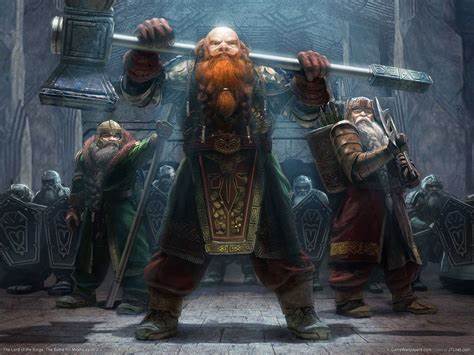 The Second-Born. The Dwarves of Khazad-dûm.
The Second-Born. The Dwarves of Khazad-dûm.Through the first few chapters as we got to know the beginning of Middle-earth we came to understand that Ilùvatar created his own children, the Elves and Men. There were so many other races not represented here which had me questioning their origins, none more than Dwarves. The Dwarves of Middle-earth are a prideful and powerful bunch and knowing just a bit about their history with Elves, I wondered where and how they came into the story.
Well this chapter starts us off in the first sentence: “It is told that in their beginning the Dwarves were made by Aulë in the darkness of Middle-earth; for so greatly did Aulë desire the coming of the Children, to have learners to whom he could teach his lore and his crafts, that he was unwilling to await the fulfillment of the designs of Ilùvatar.“
So Aulë created the dwarves at the same time Elves and Man were being created, and “because the power of Melkor was yet upon the Earth” he made the Dwarves “stone-hard, stubborn, fast in friendship and in enmity.” He also made their lives long, longer than Men, but not eternal like the Elves.
When he created them (in the true fashion of Prometheus disobeying Zeus and giving humans fire), Ilùvatar was angered, because he had yet to finish creating his own children; but when Aulë showed that he was willing to smite them with his hammer, Ilùvatar took pity on them and we get the opening quote of this essay.
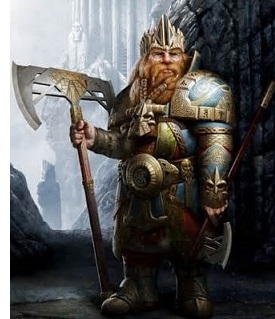 Durin, best known Father of the Elves.
Durin, best known Father of the Elves.Aulë had promised the Dwarves they would sit at the End of the World with the Children of Ilùvatar, led by the Seven Father’s of Dwarves, “of whom Durin was the most renowned in after ages, father of that kindred most friendly to the Elves, whose mansions were at Khazad-dûm.” In case you don’t recognize this name from either the books or the movies, the better known name for Khazad-dûm is The Mines of Moria.
So now we know the Dwarves were created by Aulë as the “Second Born.” and were sequestered in Moria to await the coming of the First Born, aka the Children of Ilùvatar, aka Elves and Men.
But what of Yavanna? We’ve only spoken of Aulë and the chapter head has both of their names! Well, because Aulë kept his creations a secret even from Yavanna, the Dwarves ended up not caring much about her creations, instead, “they will love first the things made by their own hands, as doth their father. They will delve in the earth, and the things that grow and live upon the earth they will not heed.“
Yavanna was afraid for her great creation…nature. The bountiful trees and the beautiful forests were potentially in danger, because of the nature of Aulë, the smith, he instilled in his children that they should be desirous of making their own creations through industry. If Melkor got his desires into these industrial Dwarves, what was to stop them from cutting down Yavanna’s beautiful forests to use in their production?
Yavanna went to Manwë, the Valar of Wind and Sky and spoke her fears:
 The Great Eagles
The Great Eagles“Because my heart in anxious, thinking of the days to come. All my works are dear to me. Is it not enough that Melkor should have marred so many? Shall nothing that I have devised be free from the dominion of others?” They discussed it for a while until Manwë finally responded, “When the Children awake (the Dwarves), then the thought of Yavanna will awake also, and it will summon spirits from afar, and they will go among the kelvar (the fauna of Middle-earth) and the olvar (the flora of Middle-earth), and some will dwell therein, and be held in reverence, and their just anger shall be feared.”
This breath of spirits and life created two powerful and fascinating beings, The Great Eagles and the Ents. Yavanna was able to work with Manwë to build a defense system into her creations, thus bringing sentience to the Great Eagles (which you’ll remember from the end of The Lord of the Rings, when Gandalf speaks with them and gets them to assist in gathering up the Hobbits) and the Ents (Yay Treebeard!) as guardians, so that even if Melkor’s influence encroaches upon the Children (both first-born, Elves and Man, and Second Born, Dwarves) and they foster a desire to mar the land further than even Melkor was able to, these sentient beings would be there for protection.
We are finally getting a broader understanding of how the world came into being, but what transpired to bring the Children to wake into the world? Let’s find out next week as we unfurl “Of the Coming of the Elves and the Captivity of Melkor.”
September 30, 2021
Blind Read Through: J.R.R. Tolkien; The Silmarillion, Of The Beginning of Days
 Melkor’s fortress, Utumno
Melkor’s fortress, Utumno“Behind the walls of the Pelóri the Valar established their domain in that region which is called Valinor; and there were their houses, their gardens, and their towers. In that guarded land the Valar gathered great store of light and all the fairest things that were saved from the ruin; and many others yet fairer they made anew, and Valinor became more beautiful even than Middle-earth in the Spring of Arda; and it was blessed, for the Deathless dwelt there, and there naught faded nor withered, neither was there any stain upon flower or leaf in that land, nor any corruption or sickness in anything that lived; for the very stones and waters were hallowed.“
Welcome back to another Blind Read! This week we begin our pathway into the Quenta Silmarillion and learn of the beginning of the First Age, while getting some very useful backstory into the elves and man.
In the past few weeks we were introduced to the Valar and their predilections and abilities, which is imperative back story as we jump into the Silmarillion.
The story starts with mention of the First War, and if you remember, we don’t really know anything about it, because we’re getting everything from the Eldar, and the First War was before they came into their own in Arda. What we do know is that Melkor fought the Valar for control of the land, until Tulkas the Strong came down and “Melkor fled before his wrath and his laughter.“
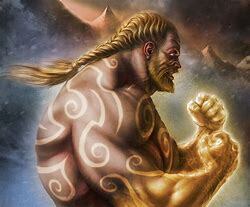 Rendition of Tulkas the Strong
Rendition of Tulkas the StrongWith Melkor gone, at least temporarily, the Valar began to build Arda bringing “order to the seas and the lands and the mountains.” Once Yavanna planted seeds, the Valar realized they needed light to help life flourish, so Aulë “wrought two mighty lamps for the lighting of Middle-earth… One lamp they raised near the north of Middle-earth, and it was named Illuin; and the other was raised in the south, and it was named Ormal.”
The land flourished with the Valar and the light of the lamps, but Melkor had spies among the Maiar, “and because of the light of Illuin they did not perceive the shadow in the north that was cast from afar by Melkor.”
Because they didn’t notice Melkor, he came south and “began the delving and building of a vast fortress, deep under the Earth, beneath dark mountains… That stronghold was named Utumno.” His corruption spread from Utumno “and the Spring of Arda was marred.”
Another war broke out and Melkor “assailed the lights of Illuin and Ormal, and cast down their pillars and broke their lamps.” causing “destroying flame (which was) poured out over Earth,” scarring the land. The Valar were able to stop Melkor after this, but it was too late and “Thus ended the Spring of Arda.“
The Valar decided that there was no appropriate place to live, “Therefore they departed from Middle-earth and went to the land of Aman,” and to protect this land “they raised the Pelóri, the Mountains of Aman, highest upon Earth.” Upon the highest mountain Manwë (the Lord of Air and Winds) build his throne. “Taniquetil the Elves name that holy mountain.” Then we get the quote which opens this essay, and we understand that this land of Aman, had now become Valinor.
It was then, once they made their home in Valinor that Yavanna helped grow (through her song) the “Two Trees of Valinor;” Telperion and Laurelin. Telperion bloomed for six hours then stopped, then Laurelin bloomed for another six hours: “And each day of the Valar in Aman contained twelve hours, and ended with the second mingling of the lights, in which Laurelin was waning and Telperion was waxing.” It was a time of great joy for the Valar, to be free of Melkor and to continue to develop Valninor:
“Thus began the Days of the Bliss of Valinor; and thus began also the count of time.”
What significant about this is the aspect of time. The age of the Children of Ilùvatar was coming and the instance of time was it’s catalyst. The Elves are immortal, they “die not till the world dies, unless they are slain or waste in grief.” But men are mortal and they need to have a concept of time to understand what their life capability is. We’ll see more of this later in the essay.
 Depiction of Valinor
Depiction of ValinorBut in this coming of the Children of Ilùvatar, Melkor still dwelt in Middle-earth, which is where the Children took up their home.
The Valar rarely came across Pelóri, but when they did they taught the Elves “the lore of all craftsmen: the weaver, the shaper of wood, and the worker in metals; and the tiller and husbandman also.” But it was the Noldor, the “most skilled of the Elves” whom were “the first to achieve the making of gems; and the fairest of all gems were the Silmarils, and they are lost.” I’m trying to take this one step at a time, but seeing as this history is called “The Silmarillion,” I’m sure they will come into play soon.
The Vanyar Elves were gifted the art of “song and poetry” by Manwë whom was named the “vicegerent of Ilùvatar, King of the world of Valar and Elves and Men, and the chief defense against the evil of Melkor.” he even wields a “scepter of sapphire, which the Noldor wrought for him.”
Then there was also Ulmo of the Oceans and seas. I’m going to give you a long passage and break it down, because to me, this is the most important passage in this chapter:
“In the deep places he gives thought to music great and terrible; and the echo of that music runs through all the veins of the world in sorrow and in joy; for if joyful is the fountain that rises in the sun, its springs are in the wells of sorrow unfathomed at the foundations of the Earth… And thus it was by the power of Ulmo that even under the darkness of Melkor life coursed still through many secret lodes, and the Earth did not die; and to all who were lost in that darkness or wandered far from the light of the Valar the ear of Ulmo was ever open; nor has he forsaken Middle-earth, and whatsoever may since have befallen of ruin or of change he has not ceased to take thought for it, and will not until the end of days.”
 Ulmo and a Noldor
Ulmo and a NoldorNot only is this passage poetic and beautiful, but it also gives form to the philosophy of Middle-earth as the personalities of the Valar form the very fabric of reality. There is and always will be a subset of people whom believe that the ideal of The Lord of the Rings is a power struggle between good and evil. Between happiness and sorrow. Between love and loss.
The end of the books and movies (as Frodo heads to Valinor) there is a certain forlorn sorrow, but infused within that thread is hope, and that’s what strikes me the most in this passage above. There is joyfulness, but that joyfulness is countered by “sorrow unfathomed.” The point is if there were only goodness, there would be no joyfulness. Men and Elves are the Children of Ilùvatar and thus are more open to emotion and feeling. The Valar only have a little bit. So if everything were always joyful, the point of joyfulness disappears because there is no counterpoint. It is only upon feeling sorrow that we understand what Joy truly is.
This sorrow does not mean the terror that Melkor had wrought, or even Sauron in The Lord of the Rings. This is speaking of the normal every day sorrow, and that comes along with the concept of time which the Valar created with the two great trees of Valinor. To burrow this down to brass tacks, it is the sorrow that Men have a finite time on Middle-earth that creates the joyfulness that they flourish off of. What Ulmo does is put the sorrow in “the foundations of earth” meaning both that it was around at earth’s inception, but it’s also deep in a well; deep in the earth; physically and metaphorically tying the song of the sorrow to Middle-earth as a place. Michael Ende used this concept to full effect in his Swamps of Sorrow of The Neverending Story.
 Swamps of Sorrow from the Neverending story. one of the most sad moments of film history
Swamps of Sorrow from the Neverending story. one of the most sad moments of film historyBut what is the point of having Men and Elves live on Middle-earth? The Elves “shall be fairest of all earthly creatures, and they shall have and shall conceive and bring forth more beauty that all my Children.” So the Elves are there to make Middle-earth a wonderous and beautiful place. But what of Men?
“Therefore he willed the hearts of Men should seek beyond the world and should find no rest therein; but they should have a virtue to shape their life, amid the powers and chances of the world, beyond the Music of the Ainur, which is as fate to all things else; and of their operation everything should be, in form and deed, completed, and the world fulfilled unto the last and smallest.“
For this the Elves fear Men, “for it seems to the Elves that Men resemble Melkor most of all the Ainur, although he has ever feared and hated them, even those that serve him.” The Elves are there for much the same reason the Valar were… to continue to make the world beautiful. Man was there to give direction and purpose. This is a powerful responsibility and it’s why many are corrupted during their journey, but it also gives rise to the joyful sorrow that one feels as they look out across the crashing waves and into the depths of the beautiful Ocean and it’s terrible wine dark composure.
Join me next week as we move onto chapter two and learn more of the Valar Aulë and Yavanna!
September 23, 2021
Blind Read Through: J.R.R. Tolkien; Valaquenta
“Among those of his servants that have names the greatest was that spirit whom the Eldar called Sauron, or Gothaur the Cruel. In his beginning he was of the Maiar of Aulë, and he remained mighty in the lore of that people. In all the deeds of Melkor the Morgoth upon Arda, in his vast works and in the deceits of his cunning, Sauron had a part, and was only less evil than his master in that for long he served another and not himself. But in after years he rose like a shadow of Morgoth and a ghost of his malice, and walked behind him on the same ruinous path down into the Void.”
Welcome back to another Blind Read! This week we dive deeper into the world of the Valar to get a better understanding of who those angels are, all the while understanding more and more about Tolkien’s process.
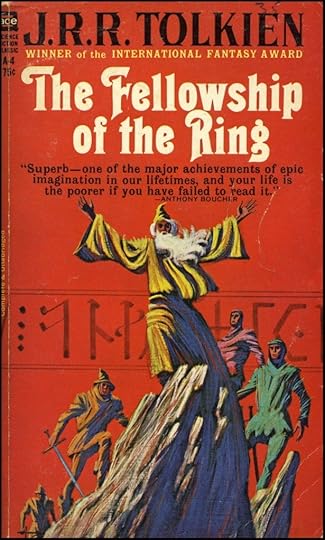
We jump right into the thick of things. Tolkien as I’m sure anyone who is reading this right now knows, was first and foremost a linguist, and famously created the Elvish language on it’s own. Once he had it he wanted to use it so he created a story around it, and thus arose The Lord of the Rings. Knowing this I figured that The Valaquenta was the story of the Valar, because quenta seems to be Tolkien’s etymology for story or history, and so to tell the story of the Valar would be the Valaquenta. Much like the first history in the book The Silmarillion, Ainulindalë, is about the land (dalë) that the Ainur created.
There is quite a bit of re-hashing of Ainulindalë in the Valaquenta as the Ainulindalë was almost a biblical genesis story, the Valaquenta is the story of the Valar; the Ainur who went down to Ëa (the Earth) and lived invisibly amongst the Children of Ilùvatar (namely the Elves and Men). This is much more of a introduction to these Valar whom I’m sure will be more important later. In fact this history even begins with the title “Account of the Valar and Maiar according to the lore of the Eldar.”
The first two paragraphs paraphrase the events in Ainulindalë, but then we get into more of a diversity of the Valar and who they are. We find that “The Lords of the Valar are seven; and the Valier, the Queens of the Valar, are seven also.” We also find that “Melkor is counted no longer among the Valar, and his name is not spoken upon Earth,” despite the fact that Melkor was the strongest of the Ainur. His fall from grace has surrendered his name from the ranks of the Valar. Because of this, Manwë is the next in line.
 The Valar
The Valar“Manwë is the dearest to Ilùvatar and understands most clearly his purposes. He was appointed to be, in the fullness of time, the first of all Kings; and with Manwë (The Lord of the Breath of Arda) dwells Varda, Lady of the Stars.” The two of them reside in Valinor (the great resting place of the elves, and in general the home of the immortal Valar. Also known as Aman). “Of all the Great Ones who dwell in this world the Elves hold Varda most in reverence and love.”
Next we are introduced to Ulmo who we already know is the Lord of the Seas, but what we find is that “He is alone.” There is no Valier which resides with him, and though “the arising of the King of the sea was terrible,” “Ulmo loves both Elves and Men, and never abandoned them.“
Then there is Aulë who has “lordship… over all the substances of which Arda is made.” Aulë is “a smith and a master of all crafts.” The elves (The Noldor, the second clan of Elves) “learned most of him” which created a larger rift with Melkor, because Aulë was a friend of the Children of Ilùvatar and Melkor wasn’t. Aulë’s spouse is Yavanna who is also known as the Queen of the Earth, or Kementári in the Eldarin tongue.
There is Námo and Irmo, who are bretheren, and known as the masters of spirits; whom are better known by the names of their homes, which are Mandos and Lórien. The two brothers are known as the Fëanturi, which on a quick glace looks to me a lot like Fae, or the magical creatures from a different realm. Kind of makes sense, especially when we get more information about them. Mandos is “the keeper of the Houses of the Dead, and the summoner of the spirits of the slain.” while Lórien is “the master of visions and dreams.” This falls right in line with the style of magic the classic Fae utilize.
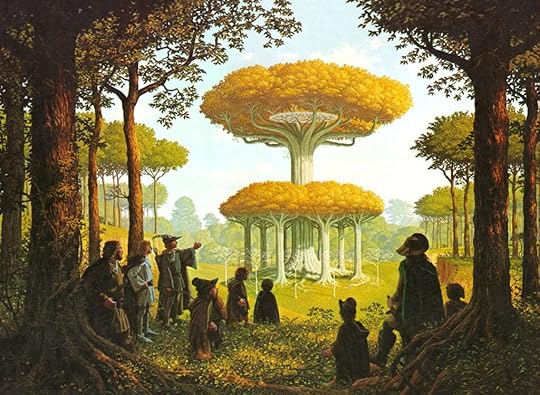 Lothlorien
LothlorienBoth brothers have spouses who are also involved in these Fae type works. Vairë is Mandos’ wife who “weaves all things that have ever been in Time into her storied webs.” Estë is Lórien’s wife and she is the “healer of hurts and weariness.” But beyond these two, in Lórien there is a mightier Valier than Estë… Nienna. “She is acquainted with grief, and mourns for every wound that Arda has suffered in the marring of Melkor. So great was her sorrow, as the music unfolded, that her song turned to lamentation long before its end, and the sound of mourning was woven into the themes of the world before it began.” I can almost hear “shadows of the past” conducted by Howard Shore as I contemplate what this means. Melkor not only caused strife, but on top of that, grief and sorrow were not known emotions in the Children of Ilùvatar until Nienna felt them and sang them into existence. All because of Melkor’s revolts.
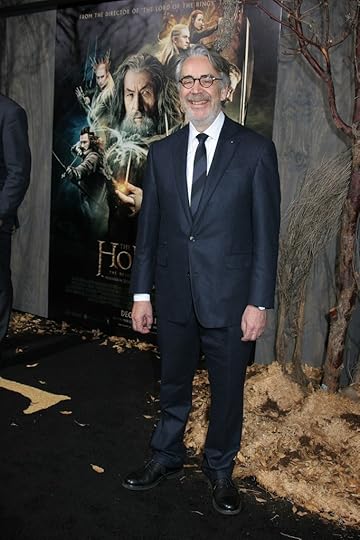 Howard Shore, the Composer of the Lord of the Rings Soundtrack
Howard Shore, the Composer of the Lord of the Rings SoundtrackNext we have the great hunter Oromë, who is “a hunter of monsters and fell beasts, and he delights in horses and hounds; and all trees he loves, for which reason he is called Aldaron, and by the Sindar Tauron, the Lord of Forests.” And of course a great hunter must have a great horn, which he calls The Valaróma. Vána, “The Ever-young” is his spouse, and is the Lady of spring.
Then the last of the Valar is Tulkas, the “Greatest in strength and deeds of prowess.” He came to Arda to aid in the battles against Melkor and his spouse is Nessa; fleet of foot and lover of dance.
Next we spend some time covering the the Maiar, whom came with the Valar to Arda, and were servants to the Valar. They were: Ilmarë a handmaiden of Varda, Eönwë whom is the banner-bearer of Manwë, Ossë whom is a vassel of Ulmo and protected the Númenóreans, Uinen who has a delight in violence, Melian who served Vána and Estë, and finally Olórin who learned pity and patience.
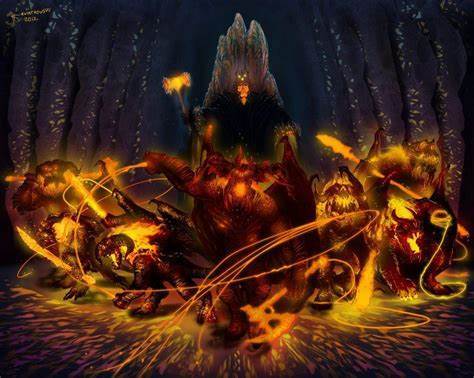 Melkor and his Balrogs
Melkor and his BalrogsBut there were other Maiar. Maiar who were drawn to the horrible splendour that was Melkor, and they were corrupted “to his service with lies and treacherous gifts.” These were known as the Valaraukar (a verbal amalgam of Melkor and Valar), “the scourges of fire that in Middle-earth were called Balrogs, demons of terror.”
The last among these Maiar, is obviously the most infamous and we see that in the opening quote of this essay: Sauron, or Gorthaur the Cruel. The Maiar that would later become the scourge of the Third Age and little Hobbits everywhere.
These two histories were obviously notes of a larger narrative in which Tolkien was building. They overlap and expound upon the previous one to show more and more of what the world of Arda really is, but they don’t have a through line or story to grab a hold of. I do, however, get the feeling that all of these names and places are going to be extremely important moving forward as we delve deeper into the lost tales.
So join me next week as we begin our journey into the Quenta Silmarillion!
September 16, 2021
Blind Read Through: J.R.R. Tolkien; Ainulindalë
 Melkor, the fallen Ainur
Melkor, the fallen Ainur“For the Children of Ilúvatar were conceived by him alone; and they came with the third theme, and were not in the theme which Ilúvatar propounded at the beginning, and none of the Ainur had part in their making. Therefore when they beheld them, the more did they love him, being things other than themselves, strange and free, wherein they saw the mind of Ilúvatar reflected anew, and learned yet a little more of his wisdom, which otherwise had been hidden even from the Ainur.”
Welcome back to another Blind read! It’s been a while, but we’ve now completed all of H.P. Lovecraft and here is the first J.R.R. Tolkien! This week we dive into the origins of Middle-Earth as we begin our journey through “The Silmarillion.”
What I didn’t realize getting into this was that “The Silmarillion” is actually only a portion of the whole book. Theres’ this entrance, Ainulindalë, then the Valaquenta, and then it gets into the Quenta Silmarillion which is the bulk of the book. All told this story is, “an account of the Elder Days, or the First Age of the World.” Where The Lord of the Rings takes place at the end of the Third Age, this is the genesis story of how that land came to be.
 Depiction of Ilùvatar
Depiction of IlùvatarWe begin with “Eru, the One, who in Arda is called Ilùvatar.” I’m sure more will come clear as we move forward, but Arda is what the Elves call Earth, not Middle-Earth, so at some point in the future there must have been a rift which caused a separate world or just continent to come about. That may be because of the first Dark Lord, Melkor, who’s introduced in this history.
So Ilùvatar created the first beings to inhabit the world and the stars, and these beings were called Ainur, The Holy Ones. They “were the offspring of his thought, and they were with him before aught else was made.”
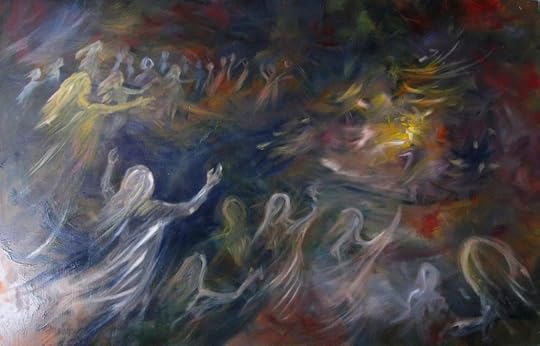 The Ainur creating their themes.
The Ainur creating their themes.Ilùvatar “spoke to them, propounding to them themes of music; and they sang before him, and he was glad.” If that sounds like a bible verse, it’s intentional. Ilùvatar teaches them three themes of music. Bear in mind that he doesn’t teach them songs, but themes. The important distinction is that Ilùvatar is looking to create more than just the Ainur, he wants to see life expand, so the Ainur in turn use these themes to create Arda. The three themes, sung into verse, created different aspects of the world, and began to shape the history of what was to come. The Ainur were content to build this world, and revel in is splendor… except for one exception… Melkor.
“But as the theme progressed, it came into the heart of Melkor to interweave matters of his own imagining that were not in accord with the theme of Ilùvatar; for he sought therin to increase the power and glory of the part assigned to himself.”
To do so, Melkor “Had gone often alone into the void places seeking the Imperishable Flame; for desire grew hot within him to bring into Being things of his own.”
Melkor began to sing discordantly and outside of the themes Ilùvatar laid our for the Ainur, “until many of the Ainur were dismayed and sang no longer.” Ilùvatar then rose, “and he lifted up his right hand, and behold! a third theme grew amid the confusion, and it was unlike the others.” This third theme was the creation of Ilùvatar’s children… The Elves and the Men.
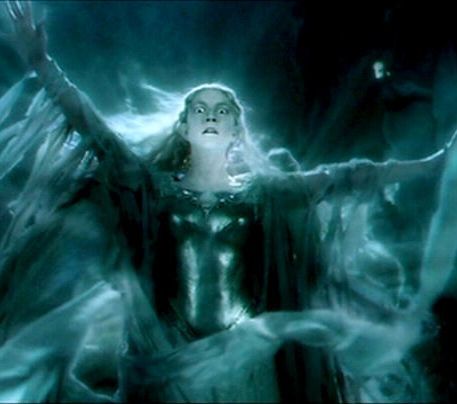 Galadriel the beautiful and terrible
Galadriel the beautiful and terribleThe music was discordant, with many battling melodies led from Melkor’s tones, until Ilùvatar stood, “and his face was terrible to behold.” This nearly reminds me of the influence of the one ring on Galadriel, to the point that I had to put the book down and contemplate where the power of that One Ring came from… could Ilùvatar be the source?
Ilùvatar shuts the Ainur down and shames Melkor: “And thou, Melkor, shall see that no theme may be played that hath not its uttermost source in me, nor can any alter the music in my despite.”
This is a very Old Testament thing to do. Ilùvatar created the Ainur from his thought and then gave them the themes to create the world. In text this seems to indicate that Ilùvatar wanted them to run with the themes and create the world (Arda) with the essence of the themes, but to create through their own lens. Melkor takes this a step too far, but Ilùvatar seems surprised that Melkor “The mightiest among them (Ainur)” might be able to actually take that step further. Then Ilùvatar tells them that they need to calm down; that they have no free will, because anything that they create with their music, was already foreseen by him. That everything they create is of him. That they cant in fact create anything that isn’t of his mind.
This seems to me the first big lie of Arda. If, indeed, Ilùvatar felt that this was true (the Ainur only being able to create what he could conceive) then why did he stop them? Why did his anger grow so much that he was “terrible to behold?” It’s because he had a specific vision and Melkor was leading a charge to alter that vision.
This strange reaction embarrasses Melkor and shames him, which only builds to bring out the darker side of desire.
Once Ilùvatar creates his Children (the elves and men), he decides he needs a place to house them, so “he chose a place for their habitation in the Depths of Time and in the midst of innumerable stars.” Which he names Ëa and it houses Arda.
The Ainur, once seeing the creation of Ëa, “…bent all their thought and their desire towards that place.” and this is where Melkor really begins his Satanesque fall. The Ainur are basically Angels (we’ll get into that a bit more in a minute) of which Melkor is one, but because of Hubris and desire, he creates a rift in the Ainur. He, much like many of the other Aniur who went to Ëa to assist in creation of that world, went “to go thither and order all things for the good of the Children of Ilùvatar…” but soon realizes that his jealousy and desire for power brought him there instead to “subdue to his will both Elves and Men,” because of “envying the gifts with which Ilùvatar promised to endow them.” A story which echoes the fall of the Lightbringer very closly.
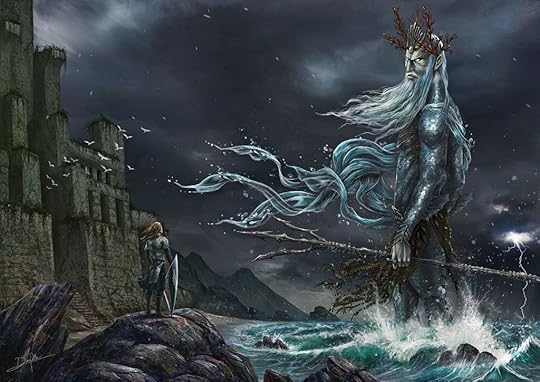 Depiction of Ulmo
Depiction of UlmoThe other Ainur who went to Ëa, were soon to become known as the Valar. There was Ulmo whom turned his thought to water and who “of all most deeply was he instructed by Ilùvatar in music.” It is because of this teaching that “it is said by the Eldar that in the water there lives yet the echo of the music of the Ainur more than in any substance else that is in this Earth.” (also another interesting aside. This is the only time in this history that Tolkien calls Ëa “this” Earth. Meaning that this was meant to be a history of our own world, which could also account for the very Christian backstory). There is Manwë, “the noblest of the Ainur” who was of the airs and the winds. Aulë who “Ilùvatar had given skill and knowledge scarce less than Melkor” took to the “fabric of Earth.”
These Valar were named “The powers of the world” and shaped Ëa in Ilùvatar’s ultimate vision, “but Melkor too was there from the first.”
Melkor finally had his fall. He claimed Ëa for his own, “This shall be my own kingdom; and I name it unto myself!” but again he was foiled because Manwë “called unto himself many spirits both greater and less, and they came down into the fields of Arda and aided Manwë.” to drive Melkor away.
There was peace for a time and the Valar, whom were imperceptible to the Eldar (the first of Ilùvatar’s children, the Elves) decided they wanted to walk among them, so they clothed themselves to look like Men and Women, but when Melkor perceived this and “His envy grew then the greater within him; and he also took visible form, but because of his mood and the malice that burned in him that form was dark and terrible.“
Again this follows the idea that these Valar are angels and Melkor is the fallen. They are invisible, except for when they wish to walk amongst the mortals and they can clothe themselves in our skin. They are beholden to Ilùvatar (God) and follow his instructions on creating a world for the Children of God, who are given more than they. But it is the Jealousy of Melkor which is the primary forge to create what the world could be. What’s fascinating in this respect is that Ilùvatar gave Melkor more intelligence and ability than any of the other Ainur, but if what he says is true and nothing can be created without his influence, then Melkor’s fall was known and, “Thus began the first battle of the Valar with Melkor for the dominion of Arda.” Of this battle little is known because the Valar struggled to keep the machinations of the Ainur from the Eldar, but Melkor fought against the Valar, and extended the creation of the world.
The only reason we know the outcome of that battle is because we know the world was created so we know Melkor failed in taking over the land, though the next history in the book is the Valaquenta, which is the account of the Valar from the perception of the Eldar, so I anticipate finding more out about these godlike beings and what they have done on Ëa!
Join me next week as we dive deeper into the history of Middle-Earth as we read through Valaquenta!
September 9, 2021
H.P. Lovecraft Final Thoughts
“It is absolutely necessary, for the peace and safety of mankind, that some of earth’s dark, dead corners and unplumbed depths be let alone; lest sleeping abnormalities wake to resurgent life, and blasphemously surviving nightmares squirm and splash out of their black lairs to newer and wider conquests.” – H.P. Lovecraft
Welcome back to another Blind Read! Well we’ve officially done it. We’ve read through every H.P. Lovecraft story I could find as well as all the August Derleth stories attributed to Lovecraft. I’ve already covered my final thoughts on August Derleth (which you can find here), so I wont be mentioning his work here, but I intend on covering Lovecraft’s writing style, touching on some of the work and making recommendations.
 The Necronomicon
The NecronomiconFirst and foremost, Lovecraft is a hard nut to crack. If you’re a casual reader his catalogue can be quite daunting. His language is archaic and complex, and his exposition is dense and verbose. I had no idea where to start when I began reading Lovecraft, and I dont think I started in the right place, but I intend on shining a light here in the dark places of Howard Phillips’ mind for the neophyte.
To me, the absolute best place to start to get into Lovecraft is the story “The Festival.” “Some fear had been gathering in me, perhaps because of the strangeness of my heritage, and the bleakness of the evening, and the queerness of the silence in that aged town of curious customs.”
The Festival holds all the elements you want in an introduction to Lovecraft. Ancestral ties, intense and submersed atmosphere, A classic Lovecraftian township, witchcraft, cosmic horror… you name it and this story has it. It follows our classic unreliable narrator as he heads to Kingsport for Yuletide whose, “fathers had called me to the old town...” There he finds himself involved in a nefarious ritual which includes the Necronomicon.
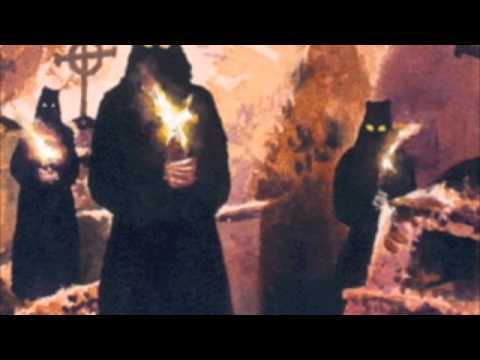 The priests of “The Festival”
The priests of “The Festival”This wasn’t the first story I read of Lovecraft, but it was the turning point for me. Before reading this story I was on the fence, I really wasn’t sure if I liked the writing or not. I was upset because I thought there was going to be far more monsters and aliens and things like that interspersed within the text. What this story made me realize is that Lovecraft is all about the feel. His text is sneaky because as you read it it kind of just glazes over you, but the longer you read, and the longer you sit with the text, the more it sinks in and that familiar anxiety attributed to good horror is subsumed in your conscious. Lovecraft is at his best when he delivers atmosphere, and this story is dripping with it. Not only that, but this is also the most accessible story in terms of readability, which makes it one of the best jumping off points for all things Lovecraft.
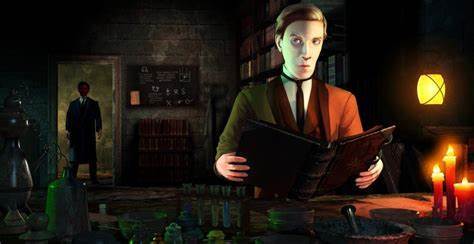 Charles and the shade of Joseph Curwen
Charles and the shade of Joseph CurwenIf you’re not into the short stories and are looking for a novel, jump right into “The Case of Charles Dexter Ward.” “He bore the name of Charles Dexter Ward, and was placed under restraint most reluctantly by the grieving father who had watched his aberration grow from a mere eccentricity to a dark mania involving both a possibility of murderous tendencies and a profound and peculiar change in the apparent contents of his mind.” Not only is this novel cleaner and an easier plot line to follow, but it has some spectacular imagery and characterization… something which Lovecraft wasn’t known for.
Told in altering perspective form, this novel gets to the core of Lovecraftian horror without being overt, nor necessarily Cosmic, but with a grand backstory which brings historical witchcraft from Salem into Lovecraft’s own mythology. In case you hadn’t realized, witchcraft is at the core of Lovecraft’s fiction. Derleth made his fiction famous for the mythos, but even with those Cosmic deities, witchcraft was the unifying base. Characters over and over again utilize witchcraft as a means to an end, which more often than not ends up reversing course on them, just like you saw in the quote above. Many of these characters, including the titular Ward, use witchcraft in the guise of what they like to call “antiquarianism” where they study old books and genealogies, but it all comes down to a few books which ends up overpowering the narrator.
“The Case of Charles Dexter Ward” follows in this tradition, but there are enough pages for Lovecraft to build some really incredible atmosphere. We go through two chapters of introductions and then Lovecraft takes his time building tension and dread until we get to the ultimate conclusion. It’s a wonderful novel and a very good introduction to longform Lovecraft.
 Trypophobia, or the fear of clusters of holes
Trypophobia, or the fear of clusters of holesDon’t expect campfire tales when you read these stories. Don’t expect to be scared out of your gourd. There’s not much in these tales that will scare you while you’re reading them. Lovecraft’s genius is his precision. Every word chosen means something. Every reference is purposeful. Even the length of a story has meaning. These are the types of stories which dig into your subconscious and stick with you far longer than you’d anticipate. These are the types of stories which so surreptitiously describe a surface that all the sudden I developed trypophobia. These are the types of stories that make you second guess the glance that stranger gave you. They aren’t going to jump off the page and yelp with fright, but like all great horror does, they settle down into your mind like a parasite and feed on deep rooted fears you didn’t even know you had…but somehow Howard Phillips Lovecraft did.
There are many other tales I cut from this list, but some amazing notables are, “Dreams in the Witch House,” “The Dunwich Horror,” “The Music of Erich Zann,” “Pickman’s Model,” and the ultimate horror short story which delivers the most visceral and terrifying text… “The Rats in the Walls.”
Pick up these stories and take them slow. Analyze the text and let the master take you for a ride!
Join me next week as we take a brand new journey, and begin with The Silmarillion by J.R.R. Tolkien!
Post Script:
I would like to thank everyone who has joined the conversation and read along with me over these past few years. I used this convention as an excuse to read through H.P. Lovecraft’s tales, and as most times you take on a long project, it changes you through the process. This series of essays has made me a better writer and reader (you can tell by reading the first few of this series), but it has also tempered my angst over other’s opinions. I never experienced any kind of negativity I would expect through a Social Media (though there were absolutely differing opinions!) endeavor like this. That’s the main reason I want to keep going and move onto another Author whom people have trouble getting into past a few of his stories. Let’s continue the conversation and continue the positivity, and continue the opposing views.
September 2, 2021
Blind Read Through: H.P. Lovecraft / August Derleth; The Lurker at the Threshold, Conclusion
 Howard Phillips and the Abominable Mi-Go
Howard Phillips and the Abominable Mi-Go“After a long enough time to allow for the assimilating of this rapidly narrated series of curious facts, I asked, ‘Conceding that the data in these rare books does offer the solution of the events which have taken place in this corner of the State during the past two hundred years and more, what then, in your opinion, is it – which particular manifestation, that is – that lurks at the threshold, which is presumably the opening in the roof of that stone tower?”
Welcome back to another Blind Read! This week we not only conclude this novel, but bring our August Derleth journey to an end as well. Derleth has brought clarity to the mystery of Lovecraft, but whether that’s a good thing or not I’ll leave that up to you to decide!
We jump into the final section of the novel leaving the mystery open as to what happened to Stephen Bates. Instead there is a jump in narrative to the perspective of Winfield Phillips who was the understudy of Dr. Seneca Lapham of Miskatonic University. We find that at the urging of Dr. Harper, apparently “late of the library staff,” Stephen Bates delivered a manuscript to Dr. Lapham and “urged Dr. Lapham to read it at once.”
The stupidity which runs rampant in this story apparently effected the previously forward thinking Bates as well, because in an effort to ameliorate his cousin he decides to perform a task asked of him by Dewart and the ersatz companion Misquamicus. They ask him to move the strange stone with the strange markings, of which Dewart previously removed from the peak of the tower, only because “…it seemed that neither he nor the Indian nor the two of them together could manage that marked stone which my cousin had dislodged from the roof of the tower.” So, naturally, Stephen does it and removes the very last vestige of protection from the area by removing the Elder Sign.
They speak for a while, and Dr. Lapham shows him a Bas-relief with a cephalopod looking creature with long tentacles, to which Bates replies “‘It looks like the things that flew about near the tower – that might have made the clawprints – but it’s also like the thing to which my cousin was talking.“
Dr. Lapham nods and shakes his hand and Bates takes his leave. The majority of the remainder of the book is a rumination on the mythos and clarification of what the mythos is. It seems obvious to me at this point (without reading the correspondence between Lovecraft and Derleth) that this novel has a direct point, beyond just being a fun horror story. This last chapter, alongside events which happened earlier in the tale, feel like Derleth sat around and decided that Lovecraft’s Yog-Sothothery was just too complicated. It was too vague for the modern reader. Derleth took it upon himself to clarify the mythos and put the various gods into specific categories because, in general, that’s how humans work…we need to put things in buckets. Lovecraft’s insidious horror was so pervasive because of how vague it was. Lovecraft relied on the brief description and let your mind do the rest of the work. This tactic ends up making for more difficult reading, but then your mind takes over and rather than letting the imagery go, it builds upon it and seethes into your unconscious. It’s like watching the original “The Haunting” movie from the sixties and then watching the 1999 remake. It’s what you don’t see that scares you. The moment you put a face to something you are suddenly able to identify it and the point of Lovecraftian horror is removed. Derleth, in trying to make the mythos more accessible, has ostensibly removed the fear from the god like characters and made them anthropomorphic. They are no longer apathetic, but now nefarious.
 Julie Harris, the terrified protagonist of the unseen enemy from “The Haunting”
Julie Harris, the terrified protagonist of the unseen enemy from “The Haunting”What Derleth does in this last portion which I did find fascinating was tying together our history through anthropology with these Elder Gods. He speaks of mysterious things like “The strange sculptures and carvings of Easter Island and Peru.” and mythological creatures such as Wendigo. We even get one of the first “almost” scientific references to ghost hunting…a precursor to books and movies such as “Hell House;” “I…will propound a theory of psychic residue, but I think it is far more than that – far, far more…” except Lapham is saying that this residue is from the outsiders, not ghosts.
To work out what their next steps are the two men then spend pages and pages of text clarifying and demystifying the mythology. We find that the Great Old Ones, “had some correspondence to the elements – as of earth, water, air, fire-” and had followers who effected certain ‘openings’ through which the Great Old Ones and their extra-terrestrial minions might enter.” who are these Great Old Ones? To Derleth, they are:
 the terrifying “scientific” ghost hunting book
the terrifying “scientific” ghost hunting book“The first among them is Cthulhu, who lies supposedly “dead but dreaming” in the unknown sunken city of R’lyeh, which some writers have thought to be in Atlantis, some in Mu, and some few in the sea not far off the coast of Massachusetts. Second among them is Hastur, sometimes called Him Who Is Not To Be Named and Hastur the Unspeakable, who supposedly resides in Hali in the Hyades. Third is Shub-Niggurath, a horrible travesty on a god or goddess of fertility. Next comes one who is described as the ‘Messenger of the Gods”-Nyarlathotep – and particularly of the most powerful extension of the Great Old Ones, the noxious Yog-Sothoth, who shares the dominion of Azathoth, the blind and idiot chaos at the centre of infinity.”
The two men then tell us, “...that without Alijah Billington was engaged in some kind of nefarious practice which may or may not have been akin to sorcery.” as they correlate what the Necronomicon says and tie it together with the history. So apparently I was wrong about Alijah not being involved, but what’s interesting is that he was the one who sealed everything up. One has to wonder if this were not just another case of an ancestor possessing his offspring for a longer life, like we’ve seen so many times before in both Lovecraft and Derleth, and when Alijah realized what was happening, he sealed off the tower with the help of the Elder sign and fled the country.
Winfield and Lapham speak of the “rules” and how they’ve all been broken.
“The water ceased to flow of itself““Dewart molested this (the stone block with the elder sign) in precisely the way Alijah hoped it would not be disturbed.“Finally, the entreaty to which reference is made in order to effect the primary stage of contact with the forces beyond the threshold.”Each and every one, with the help of Stephen Bates being stupid, has been effected and Richard, in the body of Dewart, is ready to bring forth his outsider.
In an effort to tie everything together they speak about the window: “I suggest the window is not a window at all, but a lens or prism or mirror reflecting vision from another dimension or dimensions – in short, from time or space.” and it was only when looking through this window and getting a strange vision that Dewart “felt the compulsion to dislodge the block set into the roof.”
They even get into what these outsiders are. If I’m being honest this was the story I was looking for the entire time I read Lovecraft and I’m only getting it now, here at the end of all things. We get the history of the war between the Elder Gods and the Great Old Ones and the distinction between them (I’ll put this passage in the post script), but now that I’m reading it in this context I’m a little let down, which I find curious.

I love playing board and role playing games, and have played Call of Cthulhu many times. Every time there’s a scene almost exactly like this last chapter, where the atmosphere is stuffy but cozy, as your characters uncover eldritch truths in hidden rooms or libraries. Obviously Chaosium, the company who created the games, took quite a bit of narrative out of Derleth. But there’s something missing. The depth and visceral emotional realness that is Lovecraft is missing, and that makes this feel like watching “The Librarian” instead of watching “Indiana Jones,” both you have to suspend disbelief, but somehow through character and setting and plot, Indiana just feels that much more realistic and relatable. But I digress…
Dr. Lapham tells us the way the Elder Gods were able to defeat and lock away the Great Old Ones was by the use of the Elder Sign (See? Elder Gods used their sign, which was powerful enough to lock up these alien Titans) which turns out to be “‘Armor against witches and daemons, against the Deep Ones, the Dholes, the Voormis, the Tcho-Tcho, the Abominable Mi-Go, the Shoggoths, the Ghasts, the Valusians and all such peoples and beings who serve the Great Old Ones and their spawn…carven out of grey stone from ancient Mnar…‘”
Armed with this knowledge they decide to go out and confront Richard Billington and his assistant Quamicus. They get out to the stone tower and find Billington in Dewarts body up on the tower doing the incantation to bring forth the Lurker at the Threshold:

“Iä! Iä!N’ghaa, n’n’ghai-ghai! Iä! Iä! N’ghai, n-yah, n-yah, shoggog, phthaghn! Iä! Iä! N’ghai, y-nyah, y-nyah! N’ghaa, n’n’ghai, waf’l pthaghn – Yog-Sothoth! Yog-Sothoth...”
Finally we have our Big Bad! Yog-Sothoth! The creature so pervasive on our world in Lovecraft’s opinion that he called his mythos Yog -Sothothery! This is a pretty brilliant move by Derleth to have the Lurker at the Threshold be Yog-Sothoth because that’s the diety who is closest to our world. Not floating through the ether like Azathoth, not dead and dreaming under the sea like Cthulhu, or Dagon. Not lost to space and time like Nyarlathotep (though I really want to see something with him in it! I have “Khai of Khem” by Brian Lumley another Lovecraftian antecedent, in hopes that it’s about Nyarlathotep!). This whole novel, less so the short stories I read first, seem to be a nod towards Lovecraft and a hope to bring his strange and wonderful mind to the masses, and he proves it here by bringing forward Yog-Sothoth. Or does he?
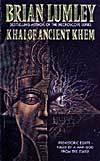
Dewart trails off at the end of the incantation because Dr. Lapham brings out a firearm, and in the most anti-climactic ending, merely shoots the man. But then! Quamicus gets up onto the tower and continues the spell! We might finally see a Great Old One…nope Lapham shoots Quamicus too, and thus ends our tale.
At least that’s how I thought it was going to end. Derleth slaps on one final paragraph right there at the end…it’s a vision of what Winfield, our narrator, thinks he sees:
“great globes of light massing towards the opening, and not alone among these, but the breaking apart of the nearest globes, and the protoplasmic flesh that flowed blackly outward to join together and form that eldritch, hideous horror from outer space, that spawn of the blankness of primal time, that tentacled amorphous monster which was the lurker at the threshold, whose mask was a congeries of iridescent globes, the noxious Yog-Sothoth, who froths as primal slime in nuclear chaos forever beyond the nethermost outposts of space and time!“
So we may not have gotten a good look at any of the Great old Ones, but we got some great insight into what they and who they are. The story itself as a total for the novel isn’t very complete, but it was interesting to see things from different characters perspectives.
The novel itself is a bit bland, and difficult to get through, not for the same reasons that Lovecraft is hard to get through, but because Derleth has a penchant for meandering. It does feel like this was the appropriate send off to this/these author/authors, because, like I said earlier, we finally got what we were initially intending on getting when I started this project those four plus years ago. A understanding about the difference between The Great Old Ones and the Elder Gods.
Is this something that’s interested you? Do you want to read Lovecraft, but are daunted by his complexity? Join me next week as we review favorite stories and final thoughts on H.P. Lovecraft!
Post Script:
As promised, here is the passage about the conflict between the Elder Gods and the Great Old Ones…
“Ubbo-Sathla is that unforgotten source whence came those daring to oppose the Elder Gods who ruled from Betelgueze; the Great Old Ones who fought against the Elder Gods; and these Old Ones were instructed by Azathoth, who is the blind, idiot god, and by Yog-Sothoth, who is the All-in-One and One-in-All, and upon whom are no strictures of time and space, and whose aspects on earth are ‘Umr At-Tawil and the Ancient Ones. The Great Old Ones dream forever of that coming time when they shall once more rule Earth and all the Universe of which it is part…Great Cthulhu shall rise from R’lyeh; Hastur, who is Him Who Is Not To Be Named, shall come again from the dark star near Aldebaran in the Hyades; Nyarlathotep shall howl forever in darkness where he abideth; Shub-Niggurath, who is the Black Goat With a Thousand Young, shall spawn and spawn again, and shall have dominion over all wood nymphs, satyrs, leprechauns, and the Little People; Lloigor, Zhar, and Ithaqua shall ride the spaces among the stars and shall ennoble those who are their followers, who are the Tcho-Tcho; Cthugha shall encompass his dominion from Fomalhaut; Tsathoggua shall come from N’kai…They wait forever at the Gates, for the time draws near, the hour is soon at hand, while the Elder Gods sleep, dreaming, unknowing there are those who know the spells put upon the Great Old Ones by the Elder Gods, and shall learn how to break them, as already they can command the followers waiting beyond the doors from Outside.”
August 26, 2021
Updates 08/26/21

Hello everyone!
I anticipated releasing the conclusion of Lurker at the Threshold today, but due to a WordPress blip, half of the essay was gone when I logged on this morning. So that essay will be coming to you next week while I re-write it, followed by an essay on some final thoughts of H.P. Lovecraft. What I want to spend the rest of this update doing is letting you know what’s coming after that!
Blind Read Series:

I’m going to transition directly from H.P. Lovecraft to J.R.R. Tolkien (I didn’t think there were enough initials in my titles!). I read The Hobbit as a child and loved it, but when I started to read The Lord of the Rings, I was stuck at Tom Bombadil. I eventually read that massive tome in three sections, but I’ve always been interested in Tolkien’s lost tales and histories. I know many people are, but the text itself is daunting, so I intent on continuing the Blind Read series and reading, analyzing, demystifying, and connecting all of Tolkien’s side tales and histories of Middle Earth. In three weeks from today I’ll release the first section of the Silmarillion!
Short Stories:
The weather is cooling and the spooky season is coming. I intend to write a number of short shorts (somewhere in the ballpark of 1000 words) to release periodically in the fall months. These are going to be similar to the Universal Monster shorts I did last year, but Halloween will be the connecting factor this year. This is a call back to all those terribly awesome 80’s horror/schlock films such as The Monster Squad, Fright Night, and Hocus Pocus (I know, I know, that one is the 90’s). So come join me for some kinda, maybe not so scary fun!

Elsie Jones Adventures:
Get ready for a new look of Elsie Jones! I’ve been passively looking for a new Illustrator to take over the series, but this fall I’ll continue in earnest. Get ready for a new authors edition of Elsie Jones and the Book Pirates, and a cleaner Elsie Jones and the Captain’s Guard. Twelve of the 15 books are written, so I anticipate a good release schedule! If you’re curious you can purchase any of the first three books here!

The Legacy:
Currently in it’s fourth edit. This is my adventure novel I finished last October. Think if Dan Brown partnered with Indiana Jones this is what you’d get! I’ve always loved the intrigue and the adventure of following the clues to discover and uncover a mystery! Inspired by the incredible Oak Island (research it if you don’t know about it). I’m hoping to have this published in some fashion in 2022.
The Monster in the Woods:
This is the first book in my Revolution Cycle. I’ve been stewing on this series for 20 years or so, and I’m finally getting it to where I want it. I’ve already written two novels that’s I’ve been unhappy with and consider exploratory novels into the world, but I’ve been spending quite a bit of time outlining everything that will go into this 10 book series. The first book is very heavily inspired by The Goonies (I’m catching a 80’s inspiration thread here), but the larger story is told with the backdrop of impending war, and how the group from the first book will deal with it. The Monster in the Woods is a Heist/Gooniesesque adventure, with a few twists along the way.
That’s all for now, with much more on the way!
August 19, 2021
August Derleth, Final thoughts

“There was something about him where he stood all by himself under the trees and the stars, on the edge of the streetlight’s glow in the darkness, that was symbolic of many men and women, not alone in this Sac Prairie, but in all the Sac Prairies of the world, something which spoke, out of that pathetic, ludicrous figure, of the spiritual isolation of so many people, something which made the thoughtful onlooker to wonder what thin line divided him from that other, knowing perhaps that the distance of chance or Providence was less great than the few steps separating one from the other in that darkness.”
Welcome back to another Blind Read! This week we’re switching gears with only one more week left in the Lovecraft series, I reflect back on the time we’ve spent talking about and analyzing August Derleth, the self imposed protégé of Howard Phillips Lovecraft.
To be brutally honest, I’ve not been a huge fan of August Derleth’s work. On the surface it seems like he hits all the bullet points, however his writing style is not conducive to the style of horror in which Lovecraft wrote. I’d actually be much more interested in reading some of his other works…in fact the quote from the introduction to this essay comes from a different story he wrote entitled, “Walden West.”
 Robert Bloch’s Lovecraft art
Robert Bloch’s Lovecraft artDerleth is one of the earlier instances of what I would consider calling the “story smith,” or campfire story teller. What I mean by that, is a few things… the text is very general and basic. The plot is straightforward and direct. The story is a direct line. Think about authors such as Robert Bloch, Richard Matheson, and Stephen King. These are not authors who spend time worrying about their word selection. These are not authors you would consider to be necessarily literary. This is not a bad thing, it’s just a different style of writing.
Lovecraft was something all together different. He was incredibly perfidious, and every word was placed in just the right place. Looking back on his stories they were difficult and complicated and, sometimes, hard to process. But that’s what made him so perfect for this kind of horror. Lovecraft’s description is written in a such a way that at first glace (or first read as it were) it doesn’t seem particularly scary, but the more it sits with you, those little turns of phrase bloom like fungus in your brain and you begin to think about the stories when you least expect them.
Derleth isn’t like that. He tries to alter his writing style to match Lovecraft’s, but instead of being insidious, it just becomes more drawn out. He uses run-on sentences and labyrinthine verbiage, but instead of feeling more like Lovecraft he ends up just sounding pretentious.
 Thomas Ligotti’s art
Thomas Ligotti’s artIt’s a bit unfortunate that Derleth decided to publish these stories as H.P. Lovecraft instead of himself, because, quite frankly, the stories would have been far greater had he just not tried to copy Howard’s style. A very specific story I can reference is “Witches Hollow” which was an utterly unique tale; told in an entirely different voice from the rest of his Lovecraft knock offs. In my opinion this was his best story because it wasn’t trying to clarify what Lovecraft had done before. It wasn’t trying to prove that it was a part of the Lovecraft ethos, it was just a great story that used elements created by Howard Phillips and moved out onto it’s own. This is what Lovecraft wanted his created world to be anyway. Other authors like Clark Ashton Smith and Robert Bloch, and later like Brian Lumley and Thomas Ligotti utilized the mythos as a unique genre rather than an homage to Lovecraft himself. Stories like this always turn out better because you can be yourself without being beholden to what the previous author wanted.
The other downfall with Derleth is his preference for quantity. He was known to have said that he could sit down and write a “quality story” every day. The issue is that he never checked his facts, nor did he care overly much about grammar and spelling errors (this is an assumption on my part because of all the syntax, grammar, and Lovecraft facts which were incorrect. He may be very happy with the outcomes here). You could say the same about Carroll and Graf (the publisher of the books I read by Derleth…which I probably wouldn’t recommend if you could find another version), and it’s possible that it’s their oversight here and not his. But the larger issue is Derleth changing facts of Lovecraft to fit his story.
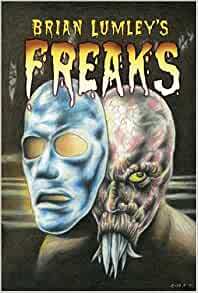
Let me clarify here. If Derleth were writing these stories as he should have been, using his own name, then I’d have zero problem with him changing facts or bending the narrative, but the moment he uses the name Lovecraft and doesn’t use his own name, that sullys the name of Lovecraft. You’ll see people online saying they hate Derleth for what he did. They hate him for using Lovecraft’s name and producing the stories he did, and there is some validity to thier argument.
I’m a little torn, because I truly believe that Lovecraft would not be in the public consciousness like he is now had it not been for Derleth creating Arkham House Publishing and continuing to produce stories in Lovecraft’s name all the way into the 70’s. Even companies such as Chaosium who produced multiple board games and the role playing game Call of Cthulhu, utilized more elements of gameplay from Derleth (The Investigator trope, and the Elder Sign) than they did from Lovecraft. Derleth is forever entrenched into this sub-culture, whether you like it or not.
Which proves that his stories had something to show off. Derleth is basically Lovecraft lite. I’d highly recommend starting with Derleth if you’ve been having difficulty breaking through the language barrier Lovecraft presents. Derleth’s stories are simpler and considerably less nuanced, which makes them easier to digest. One can get a feel for the world Lovecraft created without taking a deep dive – then once you feel the hook, you can jump into Lovecraft proper and get the real experience.
 Chaosium’s role playing game
Chaosium’s role playing gameWe’ve come a long way in the past four years. I started out not really knowing where to go with this project and it’s been so rewarding and fun to get the full experience of two different authors in one. I’ve also come to a brand new group of people and have met some great folks discussing the nuances of these authors. I really wasn’t sure if I was going to keep going, but the experience has been so great that I’m going to move onto a new author whom I’ve always wanted to dig deeper into but have been too scared to.

When I was a kid I read “The Hobbit” and I loved it. I tried to read “The Lord of the Rings,” but I had difficulty getting past the language. It wasn’t until about 10 years ago that I finally read those stories, but there were so many loose threads in that book that left me wanting more. There’s an entire history beyond the novels of those worlds and that’s what I intend on jumping into next. We have the last installment of “The Lurker at the Threshold” next week, then one final “last thoughts” on Lovecraft himself, before we switch genres and head straight into “The Silmarillion” by J.R.R. Tolkien. Join me and let me know your thoughts!



